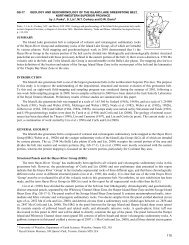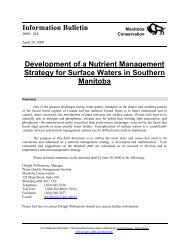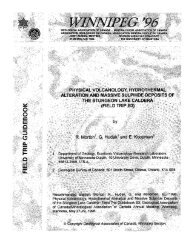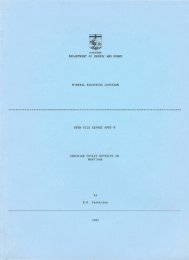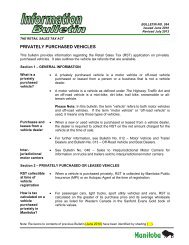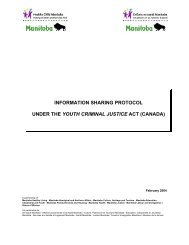Applying Manitoba's Water Policies - Government of Manitoba
Applying Manitoba's Water Policies - Government of Manitoba
Applying Manitoba's Water Policies - Government of Manitoba
You also want an ePaper? Increase the reach of your titles
YUMPU automatically turns print PDFs into web optimized ePapers that Google loves.
<strong>Applying</strong> the <strong>Policies</strong><strong>Water</strong> QualityOverviewThe quality <strong>of</strong> <strong>Manitoba</strong>’s water is a growing publicissue. As development expands to serve an increasingpopulation and to improve our living standards,and as industrial, agricultural, recreational and chemicaltechnologies advance, so increases the potential forpollution <strong>of</strong> our water resources. Despite <strong>Manitoba</strong>’sgood record <strong>of</strong> water quality management, there areareas <strong>of</strong> the province where quality is deteriorating andothers where it is threatened. Even in areas with sufficientwater, quality can vary and significantly affect itsuse, its value as a resource, and its key role in sustainingthe ecosystem. <strong>Manitoba</strong>ns are particularly concernedabout the safety <strong>of</strong> our drinking water because<strong>of</strong> the increasing frequency with which toxic substancesare being detected in supplies in some areas.pollution, and for use in addressing problems that havebeen caused either by human practices or naturalprocesses. Comprehensive water quality monitoringnetworks must be maintained to provide the necessaryinformation for guiding development planning and forguiding solutions to water quality problems.Especially important is education, to enhance publicawareness <strong>of</strong> the causes and mechanisms <strong>of</strong> waterquality degradation, and to provide guidance on themeasures which can be adopted by all <strong>Manitoba</strong>ns toprotect water quality and ensure its sustainability forpresent and future generations.The characteristics <strong>of</strong> water quality are determinedby the type and extent <strong>of</strong> dissolved and suspended substancesin it, but the judgement <strong>of</strong> quality is alsodependent on the uses to which the water will be put.For example, quality criteria for drinking water arevery stringent because <strong>of</strong> the need to protect humanhealth. In <strong>Manitoba</strong>, water is tested for up to 75 substancesand checked to ensure it meets the “<strong>Manitoba</strong>Surface <strong>Water</strong> Quality Objectives.” From place toplace water contains varying amounts <strong>of</strong> such substancesdue to differences in human activity and naturalprocesses. The extent to which the substances arepresent determines the suitability <strong>of</strong> a given body <strong>of</strong>water for various uses.In the past, water quality has <strong>of</strong>ten become anissue only after problems have developed. Oncedegradation has occurred, however, correction <strong>of</strong> theproblem can be very costly and can take a long time.The reactionary approach is not acceptable. The key tosuccessful water quality management is the prevention<strong>of</strong> pollution.Clear, publicly supported surface water qualityobjectives form the starting point or the benchmarksfor protecting <strong>Manitoba</strong>’s water for its various importantuses. Also essential are adequate water qualitydata and information, for use in planning and undertakingwater quality management, for use in preventing7



